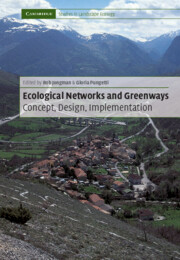Book contents
- Frontmatter
- Contents
- List of contributors
- Foreword
- Preface
- Acknowledgements
- 1 Introduction: ecological networks and greenways
- 2 The context and concept of ecological networks
- 3 Greenways in the USA: theory, trends and prospects
- 4 Ecological functioning of ecological networks: a species perspective
- 5 Impacts of roads on ecological networks and integration of conservation and transportation planning: Florida as a case study
- 6 Ecological corridors on a European scale: a typology and identification of target species
- 7 Planning the future landscape between nature and culture
- 8 From models to reality: design and implementation process
- 9 Design of the Pan-European Ecological Network: a national level attempt
- 10 Ecological ‘black spots’ within the ecological network: an improved design for rural road network amelioration
- 11 An ecological network for the Milan region based on focal species
- 12 Connecting corridors: implementing metropolitan greenway networks in North America
- 13 The Florida Statewide Greenways Project: its realisation and political context
- 14 The ecological network development in the Yungas, Argentina: planning, economic and social aspects
- 15 The river corridor of the Guadiamar
- 16 Conclusions: into the twenty-first century
- References
- Index
5 - Impacts of roads on ecological networks and integration of conservation and transportation planning: Florida as a case study
Published online by Cambridge University Press: 29 December 2009
- Frontmatter
- Contents
- List of contributors
- Foreword
- Preface
- Acknowledgements
- 1 Introduction: ecological networks and greenways
- 2 The context and concept of ecological networks
- 3 Greenways in the USA: theory, trends and prospects
- 4 Ecological functioning of ecological networks: a species perspective
- 5 Impacts of roads on ecological networks and integration of conservation and transportation planning: Florida as a case study
- 6 Ecological corridors on a European scale: a typology and identification of target species
- 7 Planning the future landscape between nature and culture
- 8 From models to reality: design and implementation process
- 9 Design of the Pan-European Ecological Network: a national level attempt
- 10 Ecological ‘black spots’ within the ecological network: an improved design for rural road network amelioration
- 11 An ecological network for the Milan region based on focal species
- 12 Connecting corridors: implementing metropolitan greenway networks in North America
- 13 The Florida Statewide Greenways Project: its realisation and political context
- 14 The ecological network development in the Yungas, Argentina: planning, economic and social aspects
- 15 The river corridor of the Guadiamar
- 16 Conclusions: into the twenty-first century
- References
- Index
Summary
Introduction
Human population growth and land development over the last century have resulted in widespread habitat loss (Kautz 1992) and fragmentation (Harris and Silva-Lopez 1992), and increased wildlife mortality on highways (Gilbert 1996; Smith 1996). The consequences of these impacts on native species diversity can be staggering. In most cases, species more adaptable to human change in the landscape (habitat generalists, medium large carnivores, and omnivores) flourish, while habitat specialists and larger, carnivorous forms decline (Crooks and Soulé 1999; Rogers and Caro 1998; Harris and Gallagher 1989).
One approach that mitigates the negative effects of expanding human development is the creation of ‘greenways’ or ecological networks consisting of an integrated system of habitat corridors, core habitat reserves and naturally isolated areas. Such ‘green’ infrastructure can maintain or restore necessary ecological processes (e.g. animal and plant migration and dispersal, hydrologic flows, fire management regimes) to once contiguous natural landscapes (Bennett 1999; Dobson et al. 1998; Csuti 1991; Harris and Scheck 1991; Harris and Gallagher 1989; Eisenberg 1986; Forman 1983). Creative use of linear parks and greenways (open space) can also restore natural amenities to urban areas and provide buffers to protect surrounding natural systems (Smith and Hellmund 1993; Little 1990).
While greenways may provide a means to restore ecological function to large-scale habitat conservation systems, most are intersected by roads that act as significant barriers to ecological processes. Proper management of these greenway–highway interfaces is necessary for maintaining the integrity of an ecological network.
- Type
- Chapter
- Information
- Ecological Networks and GreenwaysConcept, Design, Implementation, pp. 73 - 93Publisher: Cambridge University PressPrint publication year: 2004
- 2
- Cited by



